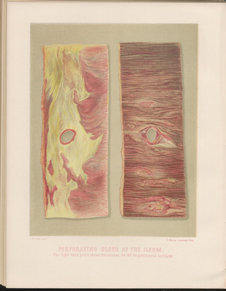Title: Whiting, Eli W.
Source text: The Medical and Surgical History of the War of the Rebellion., Part 3, Volume 1 (Washington, DC: Government Printing Office, 1888), 391.
Civil War Washington ID: med.d1e9905
TEI/XML: med.d1e9905.xml
CASE 224.—Private Eli W. Whiting, 5th Me. Bat'y, was admitted Sept. 1, 1862, with a gunshot wound received at the battle of Bull Run. He was sent to his home on furlough November 12, and was there taken very sick. He returned to hospital February 6, 1863, in a debilitated condition. On March 18 he was attacked by fever and a severe pain in the præcordial region. On the morning of the 24th he had a chill, and the seat of the pain changed to the umbilical and hypogastric regions; he lay on his back with his knees drawn up and the abdominal walls motionless in respiration; his face was pale and contracted, showing great distress and anxiety; pulse frequent and small; tongue red at the tip and edges and furred with yellow in the centre; thirst extreme; bowels constipated; he had much nausea and vomited a greenish offensive matter. He was conscious until within an hour of his death, which took place on the evening of the 25th. Post-mortem examination: A large quantity of serum and pus was found in the peritoneal cavity; the peritoneum was thickened and congested; it presented a brilliant red appearance over some parts of the small intestine and a deep-red, almost black, appearance over other parts. The ileum for about five feet from the cæcum was more or less ulcerated; it was perforated by a large ulcer at a point eighteen inches from the ileo-cæcal valve. [See specimen 147, Med. Sect., Army Medical Museum, and plate facing this page.]—Med. Cadet Abner Thorp, U. S. A., Columbian Hospital, Washington, D. C.
